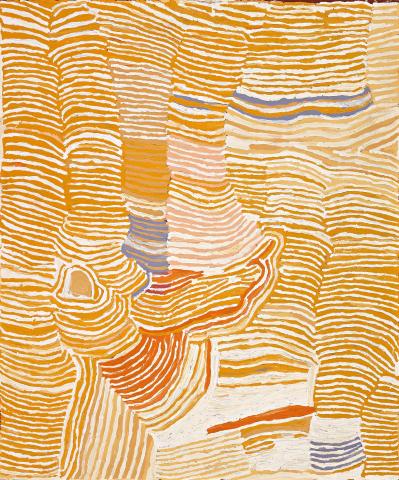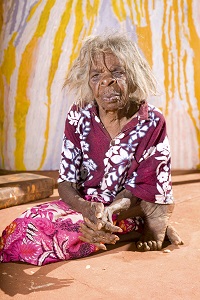LUPULNGA, 2002
MAKINTI NAPANANGKA
synthetic polymer paint on linen
183.0 x 152.5 cm
bears inscription verso: artist’s name, size and Papunya Tula Artists cat. MN0212072
Painted at Kintore in 2002
Papunya Tula Artists, Alice Springs
AP Bond Gallery, Adelaide
The Luczo Family Collection, USA
This painting is accompanied by a certificate of authenticity from Papunya Tula Artists that states: ‘This painting depicts designs associated with the rockhole site of Lupulnga, south of the Kintore Community. A group of women visited the site before continuing their travels north to Kintore. The lines in the painting represent spun hair-string which is used in the making of hair belts worn during the ceremonies associated with the area.’
Painting had been the province of Pintupi men until Marina Strocchi ran a workshop for women at Kintore in 1994.1 Although the participants were between 60 and 75 years old, they embraced the opportunity with relish, as if making up for lost time. Whereas most Pintupi men worked in established styles, senior Pintupi women began rendering their stories with gusto, taking the movement in dynamic new directions.
A diminutive woman who translated her love of dancing into a compelling urge to paint, Makinti Napanunka expresses a deep association with a tiny rockhole in the middle of a vast desert. While some artists choose to depict many different sites with which they are associated, Makinti’s paintings focus primarily on just one, Lupul(nga), a modest, rounded depression in exposed rock that collects precious rainwater, and notably, where she first encountered Europeans, with camels, during the early 1940s.2 It is a place that would be overlooked by all but the most perceptive of intruders.
From 1996, when she began painting regularly, Makinti returned to Lupul in her imagination. Her tremulous lines were formed with a loaded brush, grasped at an acute angle, and pushed forcefully across the canvas evoking the first performance by the Kungka Kutjarra (Two Women) at Lupul. The resulting contours signify the movement of nyimparra (pubic cover, made with hairstring) as women dance.3 In Makinti’s variant of desert minimalism, the nyimparra stand for both the site and the ceremony. The timbre of verses, sung to celebrate the travels of the Kungka Kutjarrais embodied in the shift and sway of Makinti’s line.
JOHN KEAN
1. Marina Strocchi (coordinator at the Ikuntji Arts Centre at Haasts Bluff, 1992 – 97) initiated the workshop with the assistance of a group of senior women artists, resident at Haasts Bluff who maintained strong associations with their relatives at Walungurru/Kintore.
2. Johnson, V., Lives of the Papunya Tula Artists, IAD Press, Alice Springs, 2008, p. 316.
3. Personal communications, Vanessa Merlino (née Patterson), who worked closely with Pintupi women as a Field Officer for Papunya Tula Artists, 2005 – 10.

